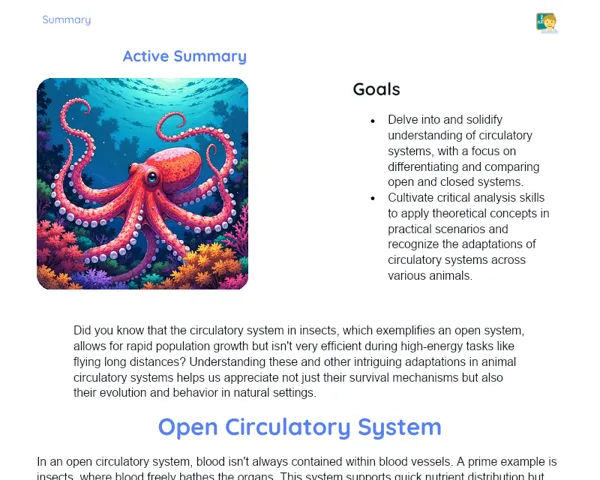Summary Tradisional | Human Body: Tissues
Contextualization
The human body is a complex entity made up of trillions of specialized cells that group together to form tissues. These tissues are the building blocks of the body's organs and systems, performing essential functions that ensure the smooth operation of the organism. A solid understanding of these tissues is crucial for grasping how the human body works in a coordinated and efficient way.
Human body tissues are categorized into four main types: epithelial tissue, connective tissue, muscle tissue, and nervous tissue. Each type possesses distinct characteristics and functions that contribute to overall health and wellness. For example, epithelial tissue acts as a protective cover, while muscle tissue facilitates movement. Connective tissue has roles in connecting and supporting various structures, and nervous tissue is pivotal for internal communication within the body. Studying these tissues is foundational for understanding human biology and its implications in fields such as medicine and physiotherapy.
To Remember!
Epithelial Tissue
Epithelial tissue is a layer of cells that lines internal and external surfaces of the body, creating a protective barrier against physical harm, germs, and dehydration. This tissue is vital for safeguarding the body and its organs, along with absorbing and secreting various substances.
Epithelial tissue comes in several forms, including simple and stratified epithelium. Simple epithelium consists of a single layer of cells and is usually found in areas where absorption and exchange are key, such as in the lung alveoli and the inner lining of the intestines. In contrast, stratified epithelium is composed of multiple layers of cells and is found in areas that experience wear and tear, like the skin and the inner lining of the mouth.
Moreover, epithelial tissue aids in the formation of glands. Exocrine glands, such as sweat and salivary glands, secrete substances either outside the body or into internal cavities, while endocrine glands, like the thyroid, release hormones directly into the bloodstream. These functions make epithelial tissue essential for maintaining the body's equilibrium.
-
Covers internal and external surfaces of the body.
-
Protects against physical damage, germs, and dehydration.
-
Participates in the absorption and secretion of substances.
-
Forms exocrine and endocrine glands.
Connective Tissue
Connective tissue is a type of tissue that connects, supports, and protects other tissues and organs in the body. It comprises scattered cells within an extracellular matrix that varies in composition and consistency, from liquid (like blood) to solid (like bone).
Various types of connective tissue serve specific functions. Adipose tissue, for instance, stores energy in the form of fat and provides thermal insulation. Cartilage gives support and flexibility to body's structures, such as the ears and nose. Bone tissue supports and protects the body, serving as a reservoir for calcium and phosphorus. Blood, as a type of liquid connective tissue, is responsible for transporting nutrients, gases, hormones, and waste throughout the body.
The extracellular matrix of connective tissue includes fibers (collagen, elastic, and reticular) and ground substance. These fibers impart resistance and elasticity to the tissue, while the ground substance varies from liquid to gelatinous to solid, depending on the type of connective tissue.
-
Connects, supports, and protects other tissues and organs.
-
Includes adipose, cartilaginous, bony tissues, and blood.
-
Extracellular matrix varies widely.
-
Composed of collagen, elastic, and reticular fibers.
Muscle Tissue
Muscle tissue is responsible for movement within the body and its organs. It consists of elongated cells known as muscle fibers, which can contract in response to nerve impulses. There are three primary types of muscle tissue: skeletal, cardiac, and smooth.
Skeletal muscle is voluntary and attached to bones, enabling conscious movements of the body. Skeletal muscle fibers are striated, featuring a pattern of light and dark bands. This type of muscle is crucial for activities such as walking, running, and carrying objects.
Cardiac muscle is unique to the heart and is involuntary, functioning automatically without conscious control. Cardiac muscle fibers are also striated but have a branched structure and are interconnected by intercalated discs, which enable rapid communication between cells, essential for synchronized heart contractions.
Lastly, smooth muscle is involuntary and located in the walls of internal organs such as the intestines, blood vessels, and bladder. Its fibers are non-striated and appear smooth. This muscle type is responsible for automatic movements, including digestion and the regulation of blood vessel diameter.
-
Responsible for the movement of the body and organs.
-
Three types: skeletal, cardiac, and smooth.
-
Skeletal muscle is voluntary and striated.
-
Cardiac muscle is involuntary and striated.
Nervous Tissue
Nervous tissue comprises neurons and glial cells, and it is responsible for communication and control of body functions. Neurons are the functional units of the nervous system, capable of generating and transmitting electrical impulses, crucial for communication across different body parts.
Neurons consist of three main parts: the cell body, which houses the nucleus and most organelles; dendrites, which receive signals from other neurons; and the axon, which sends signals to other neurons, muscles, or glands. The interplay between these parts enables rapid and efficient information transmission throughout the body.
Nervous tissue also includes glial cells, which provide essential support and protection. These cells deliver nutrients, eliminate waste, and insulate neurons, ensuring efficient impulse transmission. Various types of glial cells, including astrocytes, oligodendrocytes, and microglia, each play specific roles.
Nervous tissue is critical for the functioning of the central nervous system (the brain and spinal cord) and the peripheral nervous system (nerves that branch throughout the body). It orchestrates and regulates all bodily activities, from voluntary motions to involuntary functions like respiration and digestion.
-
Composed of neurons and glial cells.
-
Responsible for communication and control of bodily functions.
-
Neurons transmit electrical impulses.
-
Glial cells provide support and protection.
Key Terms
-
Epithelial Tissue: A layer of cells covering internal and external surfaces of the body.
-
Connective Tissue: Tissue that connects, supports, and protects other tissues and organs.
-
Muscle Tissue: Tissue responsible for the movement of the body and its organs.
-
Nervous Tissue: Tissue composed of neurons and glial cells, responsible for communication and control of bodily functions.
-
Simple Epithelium: A type of epithelial tissue of a single layer of cells.
-
Stratified Epithelium: A type of epithelial tissue made up of multiple layers of cells.
-
Adipose Tissue: Connective tissue that stores energy in fat form.
-
Cartilage: Connective tissue that offers support and flexibility to structures in the body.
-
Bone Tissue: Connective tissue vital for supporting and protecting the body.
-
Blood: Liquid connective tissue that transports nutrients, gases, and waste throughout the body.
-
Skeletal Muscle: Voluntary muscle tissue that allows for conscious body movement.
-
Cardiac Muscle: Involuntary muscle tissue specific to the heart.
-
Smooth Muscle: Involuntary muscle tissue found in walls of internal organs.
-
Neurons: Functional units of the nervous system that generate and transmit electrical impulses.
-
Glial Cells: Nervous tissue cells providing support and protection to neurons.
Important Conclusions
The tissues of the human body perform critical functions that ensure the proper functioning of the organism. Divided into four primary types—epithelial, connective, muscular, and nervous—each possesses unique characteristics and responsibilities. Epithelial tissue protects and covers surfaces, connective tissue connects and supports structures, muscle tissue enables movement, and nervous tissue controls and facilitates communication of bodily functions.
Understanding the various types of tissues is pivotal in appreciating the complexity of the human body. Epithelial tissue forms vital protective barriers, while connective tissue includes key components such as adipose tissue and blood, crucial for nutrient transport and structural integrity. Muscle tissue, comprising three types (skeletal, cardiac, and smooth), facilitates both voluntary and involuntary movements. Ultimately, nervous tissue, which consists of neurons and glial cells, is essential for internal communication and control of bodily functions.
This knowledge is indispensable not only for biology but also for careers in healthcare. Grasping how tissues operate and interact can assist in diagnosing and treating diseases, as well as enhancing quality of life. Exploring the study of tissues can pave the way for diverse research and medical practice opportunities.
Study Tips
-
Review class concepts using your Biology textbook, focusing on chapters discussing human tissues.
-
Create summaries and mind maps highlighting the characteristics and functions of each type of tissue to enhance memorization and understanding of the material.
-
Watch educational videos and documentaries about tissue biology to visualize practical examples and deepen your grasp of the subject.



